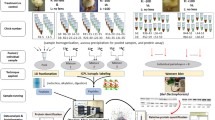Abstract
In the course of studying possible fatty acid acylation of vimentin by cultured bovine lens epithelial cells, several potential pitfalls of protein-fatty acid acylation were recognized. Even exhaustive delipidation of vimentin with organic solvents failed to remove all noncovalently associated [3H]palmitate and [3H]myristate. Hydroxylamine treatment of vimentin, separated by sodium dodecylsulfate-polyacrylamide gel electrophoresis (SDS-PAGE), failed to remove either palmitate or myristate derived radiolabel. Hydroxylamine treatment did remove palmitate label from a group of lower molecular weight proteins. The myristate radiolabel associated with vimentin recovered after SDS-PAGE and subjected to acid hydrolysis was shown due to incorporated [3H]amino acids, mainly glutamic acid, generated from the fatty acid. Adding excess sodium pyruvate to labeling media has been used by others to reduce the metabolic conversion of fatty acids to amino acids; however, no direct evidence in support of this antagonism was presented. We observed that inclusion of sodium pyruvate at between 5 and 20 mM in the labeling medium produced a dramatic decrease in incorporation of myristic acid radiolabel into vimentin. However, inclusion of even 20 mM pyruvate did not completely antagonize the metabolic conversion of fatty acid label to amino acids. Furthermore, the sodium pyruvate antagonism could be totally obscured if the exposure of X-ray film by fluorography was even slightly prolonged. The results illustrate the danger in assuming that solvent extraction totally delipidates proteins and that adding sodium pyruvate to labeling media prevents the transfer of fatty acid label to amino acids. Caution is necessary to conclude that radiolabel associated with specific proteins following incubation of cells with labeled fatty acid is due to covalent attachment of the fatty acid to the protein.
Similar content being viewed by others
Abbreviations
- DMEM:
-
Dulbecco's modified Eagle's media
- EDTA:
-
ethylenediaminetetraacetic acid
- EGTA:
-
ethyleneglycol-bis(β-aminoethyl ether)N,N,N′,N′-tetraacetic acid
- PBS:
-
physiological buffered saline
- Py :
-
pyruvate
- SDS-PAGE:
-
sodium dodecylsulfate-polyacrylamide gel electrophoresis
- TCA:
-
trichloroacetic acid
- TLCK:
-
N-α-p-tosyl-l-lysine chloromethyl ketone
- Tris:
-
tris(hydroxymethyl)aminomethane
- V:
-
vimentin
- Vd :
-
vimentin degradation products
References
Olson, E.N., Towler, D.A., and Glaser, L. (1985)J. Biol. Chem. 260, 3784–3790.
Iozzo, R.V., Kovalszky, I., Hacobian, N., Schick, P.K., Ellingson, J.S., and Dodge, G.R. (1990)J. Biol. Chem. 265, 19980–19989.
Burn, P., and Burger, M.M. (1987)Science 235, 476–479.
Georgatos, S.D., and Blobel, G. (1987)J. Cell Biol. 105, 105–115.
Stadler, J., Gerisch, G., Bauer, G., and Deppert, W. (1985)EMBO J. 4, 1153–1156.
Staufenbiel, M., and Lazarides, E. (1986)Proc. Natl. Acad. Sci. USA 83, 318–322.
Hitchner, W.R., and Cenedella, R.J. (1985)J. Lipid Res. 26, 1455–1463.
James, G., and Olson, E.N. (1989)J. Biol. Chem. 264, 20998–21006.
Laemmli, U.K. (1970)Nature (London) 227, 680–685.
Georgatos, S.D., Weaver, D.C., and Marchesi, V.T. (1985)J. Cell Biol. 100, 1962–1967.
Smith, I. (1969) inChromatographic and Electrophoretic Techniques, (Smith, I., ed.) Vol. 1, pp. 104–169, John Wiley & Sons, Inc., New York.
Lieska, N., Chen, J., Maisel, H., and Romero-Heirera, A.E. (1980)Biochim. Biophys. Acta 626, 136–153.
Ferrari, S., Battini, R., Kaczmarek, L., Rittling, S., Calabretta, B., DeRial, J.K., Philiponis, V., Wei, J.F., and Baserga, R. (1986)Mol. Cell Biol. 6, 3614–3620.
Wood, L., Theriault, N., and Vogeli, G. (1989)Gene 76, 171–175.
Nelson, N.J., and Traub, P. (1981)Eur. J. Biochem. 116, 51–57.
Ireland, M., and Maisel, H. (1984)Curr. Eye Res. 3, 423–429.
Gordon, J.I., Duronio, R.J., Rudnick, D.A., Adams, S.P., and Goke, G.W. (1991)J. Biol. Chem. 266, 8647–8650.
Schmidt, M., Schmidt, M.F., and Rott, R. (1988)J. Biol. Chem. 263, 18635–18639.
Author information
Authors and Affiliations
About this article
Cite this article
Cenedella, R.J., Mitchell, J. Antagonism of [3H]fatty acid incorporation into vimentin by sodium pyruvate: Pitfalls of protein acylation. Lipids 28, 235–240 (1993). https://doi.org/10.1007/BF02536645
Received:
Revised:
Accepted:
Issue Date:
DOI: https://doi.org/10.1007/BF02536645




